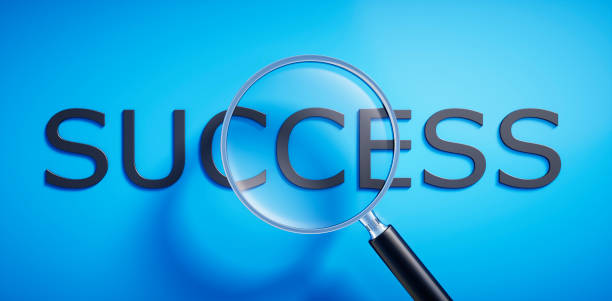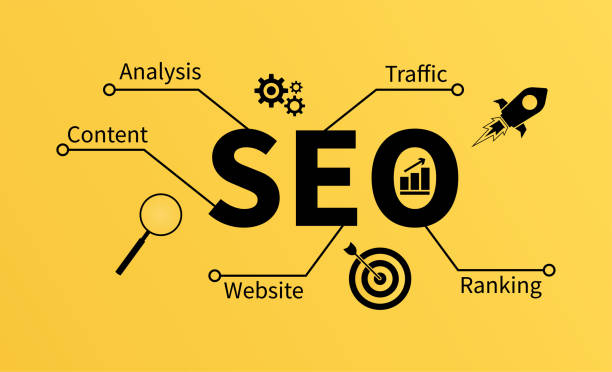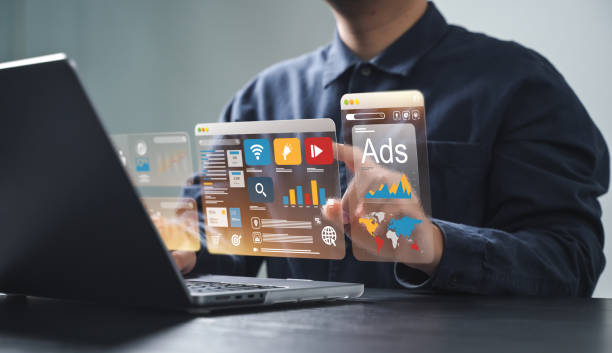Introduction to Off-page SEO and Its Importance in Ranking
![]()
In today’s highly competitive world, Search Engine Optimization (SEO) is vital for a website’s visibility.
This process is divided into two main parts: On-page SEO and Off-page SEO.
While On-page SEO focuses on improving elements within your website, Off-page SEO encompasses all activities performed outside your website to improve its ranking in search results.
The most important component of Off-page SEO is, without a doubt, backlinks; links from other websites that point to your site.
Google and other search engines view backlinks as a vote of confidence in your content.
The higher the number and quality of these votes, the more your website’s credibility increases in the eyes of search engines, which in turn leads to higher rankings in search engine results pages (SERPs).
This section provides an in-depth explanation of the concept of Off-page SEO and clarifies why it is important.
The importance of Off-page SEO is not limited to backlinks; it also includes social signals, brand mentions, and even online content marketing and public relations activities that indirectly help improve your site’s credibility and visibility.
A strong Off-page SEO strategy not only helps improve ranking but also increases organic traffic and brand awareness.
This type of SEO is a vital component, especially for new businesses or sites operating in competitive markets.
Without proper investment in Off-page SEO, even with the best On-page SEO, achieving top rankings on Google will be very difficult.
This educational approach helps you gain a deeper understanding of the various dimensions of Off-page SEO and its impact on your online success.
Backlinks act as digital votes of confidence; the more a website receives links from authoritative and relevant sources, the more search engines consider it trustworthy and authoritative.
This, in turn, leads to an increase in your site’s Domain Authority and Page Authority, which directly impacts your ranking ability.
For this reason, understanding and correctly implementing Off-page SEO is not just an advantage, but a necessity for any business aiming for online success.
This section is an initial training course for web professionals and managers who want to leverage the power of Off-page SEO.
Further in this article, we will delve into the various aspects of Off-page SEO, from link-building strategies to necessary tools and common challenges.
Our goal is to provide a comprehensive and practical guide for you to confidently formulate and implement your Off-page SEO strategies.
A deep understanding of how Off-page SEO works enables you to not only surpass your competitors but also achieve authority in your field.
Tired of losing customers due to poor e-commerce website design? With Rasaweb, solve this problem forever!
✅ Increase sales and visitor-to-customer conversion rates
✅ Smooth and engaging user experience for your customers⚡ Get free consultation
Backlinks: The Backbone of Effective Off-page SEO

Backlinks, or inbound links, are the lifeblood of any successful Off-page SEO strategy.
They act as a vote of confidence from one website to another.
When an authoritative website links to your content, it sends a message to search engines that your content is valuable and trustworthy.
The quality of these backlinks is far more important than their quantity.
A backlink from a website with high Domain Authority and relevance to your niche is dozens of times more valuable than dozens of backlinks from irrelevant or spammy sites.
This is a specialized principle in SEO that many newcomers overlook.
In fact, focusing on backlink quality is one of the most important points in the correct implementation of Off-page SEO.
This educational approach helps you build your strategies based on quality.
The types of backlinks also matter.
The two main types of backlinks are dofollow and nofollow.
Dofollow links transfer “authority” (link juice) from the source site to the destination site and have a direct impact on SEO ranking.
In contrast, nofollow links tell search engines not to transfer authority and are mostly used for links that, for any reason, do not want to pass SEO authority, such as advertisements or comments.
However, even nofollow links can be valuable in Off-page SEO, as they attract traffic and help diversify your link profile.
A diverse and natural link profile includes a mix of dofollow and nofollow links.
This is an analytical discussion that should be included in your Off-page SEO strategy.
In addition to quality and type, link placement on the page and Anchor Text are also important factors.
A link placed within the main body of the content usually holds more value than a link in the footer or sidebar, as it appears more natural and relevant.
The anchor text, meaning the words on which the link is placed, should be relevant to the content of the destination page and can help Google better understand your page’s topic.
However, excessive use of exact match and keyword-rich anchor texts can be considered spam.
Google looks for natural patterns, and diversity in anchor texts is one such pattern.
This section provides a comprehensive guide to understanding and implementing the most effective backlink strategies in your Off-page SEO.
Avoiding black hat SEO techniques such as buying bulk backlinks or using artificial link-building networks is essential for maintaining the health of your site’s SEO, as search engines are becoming increasingly smarter at identifying these unnatural patterns and can impose severe penalties.
Strong and Safe Link Building Strategies in Off-page SEO

Link building is one of the most complex and time-consuming aspects of Off-page SEO, but its correct implementation can yield significant results.
A successful link-building strategy should be multi-faceted and leverage various techniques.
The first and most effective method is content-based link building.
This involves creating highly valuable content, such as research articles, detailed infographics, original reports, or free tools, that are naturally shared and linked to by others.
This approach requires a strong content marketing strategy and serves as a key guide for Off-page SEO.
For instance, a comprehensive study on your industry trends can become a referable source that other websites link to.
Another widely used strategy is Guest Posting.
In this method, you write quality content for other websites relevant to your field and, in return, receive a link back to your site.
This method not only helps acquire backlinks but also increases brand awareness and attracts referral traffic.
However, it is crucial to ensure that these posts are truly useful and valuable and are not perceived as a spammy activity.
Finding opportunities for Broken Link Building is also a specialized method; you find broken links on other websites, then propose your similar content as a replacement.
This method requires specific tools for identifying broken links and can yield effective results in your Off-page SEO.
Avoiding black hat SEO techniques such as buying bulk backlinks or using Private Blog Networks (PBNs) is crucial for ensuring the long-term health of your site’s SEO.
Google constantly improves its algorithms to identify and penalize these tactics.
Focusing on building real relationships with webmasters and producing quality content that naturally leads to link building is the best approach.
Link exchange can also be beneficial, but it must be done cautiously and naturally to avoid being seen as spam by Google.
Finally, continuous tracking and analysis of your backlink profile and competitors’ profiles to identify opportunities and threats is an integral part of your Off-page SEO strategy.
This section provides a comprehensive guide to various link-building strategies.
| Strategy | Explanation | Advantages | Challenges |
|---|---|---|---|
| Content-based Link Building | Producing very high-quality and valuable content that naturally attracts links. | Natural and high-quality links, increased brand credibility, high traffic. | Time-consuming, requires exceptional content, needs active promotion. |
| Guest Posting | Writing articles for other websites in exchange for backlinks. | Control over anchor text, connection with authoritative sites, increased referral traffic. | Requires finding relevant sites, writing new content, can be time-consuming. |
| Broken Link Building | Identifying broken links on other sites and offering your content as a replacement. | Effective and white-hat method, opportunity to gain links from authoritative sites. | Time-consuming identification and notification process, requires good replacement content. |
| Influencer Marketing | Collaborating with influencers to promote content and receive links or brand mentions. | Access to broad audiences, increased brand awareness, attracting targeted traffic. | Costly, difficulty in finding suitable influencers, complex ROI measurement. |
Criteria for Evaluating Backlink Quality for Off-page SEO

Simply having backlinks is not enough; it’s the quality of these links that ultimately impacts your Off-page SEO.
Search engines consider multiple criteria to evaluate the value of a backlink.
One of the most important criteria is the Domain Authority (DA) and Page Authority (PA) of the source website.
These metrics, provided by Moz, indicate the predictive power of a website’s ranking in search results.
A link from a website with high DA and PA is far more valuable than one from a site with low DA and PA.
This is a specialized analysis that helps you prioritize link-building opportunities and prevent wasting resources on fruitless activities.
Topical relevance between the source site and your site is also of high importance.
A link coming from a website relevant to your industry sends a stronger signal to Google than a link from a completely unrelated website.
For example, if you have a sports equipment sales website, a link from a sports or health-related blog is far more valuable than a link from a cooking site.
This guidance helps you act intelligently when selecting sites for link building and focus on acquiring links that truly add to your site’s credibility.
This topical relevance, in fact, indicates the naturalness of the link.
Link position on the page, Anchor Text, and link freshness are other important factors.
A link placed within the main body of the content and visible to users usually holds more value than a link in the footer or sidebar.
The anchor text, meaning the words on which the link is placed, should be relevant to the content of the destination page and can help Google better understand your page’s topic.
However, excessive use of exact match and keyword-rich anchor texts can be considered spam and even lead to penalties.
Also, newer links generally have more authority than very old links, especially if the source site continuously updates its content and is active.
Finally, Spam Score, provided by Moz, or similar metrics from other tools, can help you identify potentially harmful backlinks.
A link from a website with a high spam score can be dangerous for your SEO and even lead to manual Google penalties.
Regular monitoring of your backlink profile and disavowing toxic links is an essential step in maintaining a healthy Off-page SEO strategy.
This educational section familiarizes you with the details of backlink quality evaluation criteria so you can make more informed decisions in your Off-page SEO campaigns and avoid investing in links that are detrimental to you.
Does your company’s website create a professional and lasting first impression in the minds of potential customers? Rasaweb, with its professional corporate website design, not only represents your brand’s credibility but also opens a path for your business growth.
✅ Create a powerful and trustworthy brand image
✅ Attract target customers and increase sales
⚡ Get free consultation
The Role of Social Media and Branding in Off-page SEO

Although social media signals do not directly act as ranking factors in Google’s algorithms, they play an indirect and powerful role in Off-page SEO.
Strong social media activity leads to increased content visibility, heightened brand awareness, and ultimately, more traffic to your website.
The more your content is shared on platforms like Twitter, Facebook, LinkedIn, and Instagram, the higher the likelihood that more people will see it and link to it.
This process naturally aids link building and is an indirect guide for Off-page SEO, as it increases opportunities for acquiring natural links.
Brand Mentions, even without a direct link to your website, can be valuable for Off-page SEO.
When your brand or company name is mentioned on websites, blogs, or even news media, Google considers this a positive signal of your credibility and popularity.
These mentions can help increase “Entity Salience” or institutional prominence in Google’s eyes.
For example, if a journalist or blogger talks about your company without linking, it’s a positive signal for Google that you are a real and important entity in the market.
Monitoring brand mentions and attempting to convert them into backlinks if possible (by contacting the webmaster) is a specialized and analytical strategy in Off-page SEO.
Influencer marketing is also a powerful tool for Off-page SEO and branding.
Collaborating with influencers relevant to your business can significantly help increase the visibility of your content and lead to natural and high-quality links.
When a popular influencer shares or links to your content, it not only drives targeted traffic to your site but also adds credibility and trust to your brand.
This approach is particularly effective in thought-provoking content campaigns aimed at going viral, and it can significantly increase sharing rates and referrals.
Finally, creating an active online community and interacting with users on social networks not only helps strengthen your brand but also shows search engines that you are a real and active entity.
These interactions can lead to more content sharing and, consequently, increased link-building opportunities.
Also, email marketing and using media platforms to disseminate news and announcements can indirectly help increase brand mentions and links.
A comprehensive Off-page SEO strategy should also encompass these branding and social activities to provide the maximum growth potential for your website.
This is an explanation to demonstrate the subtle connections between social networks and Off-page SEO.
Thought-Provoking and Viral Content as an Off-page SEO Lever

One of the most powerful levers for achieving success in Off-page SEO is to produce content that is not only informative and valuable but also has the potential to go viral and be thought-provoking.
Viral content is content that is rapidly shared across social media and other platforms, naturally attracting many links and mentions.
This type of content can include shocking data, interactive infographics, humorous or educational videos, or articles with fresh and bold perspectives.
Creating such content requires a deep understanding of audience psychology and current trends, and it acts as an engaging and analytical strategy.
The goal is to produce content that makes audiences think and encourages them to share it with others.
The key to producing thought-provoking content is addressing topics that are controversial, novel, or untold.
This type of content encourages people to express their opinions, share it with friends, and even link to it to strengthen their viewpoint.
For example, a case study revealing unexpected results, or an article challenging a common belief, has high potential to attract attention and natural links.
This approach significantly helps strengthen your Off-page SEO, as links are created organically without the need for direct requests and possess higher credibility.
To increase the chances of going viral, content must not only be topically engaging but also distinctive and striking in its format.
Using high-quality images, interactive infographics, animated videos, or even podcasts can differentiate your content from competitors and make it more appealing for sharing across various platforms.
Then, the content promotion phase begins.
Producing great content alone is not enough; you must share it on appropriate platforms, connect with influencers and media outlets, and use paid promotions to increase initial visibility.
This is a comprehensive guide to content distribution.
The impact of viral content on Off-page SEO is twofold: first, it directly attracts natural links; second, it increases brand mentions and awareness, which in turn adds to your site’s credibility in the eyes of search engines.
This is a specialized and long-term strategy that yields sustainable and powerful results for your Off-page SEO.
By investing in creative and engaging content, you can not only gain more traffic and links but also establish your brand as an authority in your field.
This section is a creative guide to producing content that is not only engaging but also effectively contributes to your Off-page SEO goals.
Advanced Tools and Techniques in Off-page SEO

To successfully implement your Off-page SEO strategy, using the right tools and advanced techniques is essential.
These tools enable you to analyze your and your competitors’ backlink profiles, identify new link-building opportunities, and track the performance of your campaigns.
One of the most popular and comprehensive tools in this area is Ahrefs.
Ahrefs allows you to examine any website’s backlinks, analyze competitor keywords, and discover popular content.
This is a specialized tool for every Off-page SEO expert, providing deep insights into the web’s link ecosystem.
SEMrush is also a powerful tool that offers capabilities similar to Ahrefs, plus features related to content marketing, keyword research, and advertising.
Both tools are very useful for competitor analysis and identifying backlink opportunities.
Using these tools, you can see where your competitors are getting links from and try to acquire links from the same or similar sources.
This is an analytical approach in Off-page SEO that can significantly optimize your link-building path.
Also, other tools like Moz Pro exist that help evaluate domain strength with their specific metrics like Domain Authority and Page Authority.
To find broken link building opportunities, tools like Check My Links (a Chrome extension) or the Site Explorer feature in Ahrefs can be very helpful.
These tools quickly identify broken links on a page, and you can contact the webmaster to suggest your relevant content as a replacement.
This is a guidance and practical technique for improving Off-page SEO that benefits both parties.
Another advanced technique is Link Reclamation.
This involves finding mentions of your brand on the web that don’t have a link and asking the webmaster to convert that mention into a direct link.
This is a great way to acquire natural backlinks from sources that have already mentioned you and can help increase your site’s credibility.
Using tools like Mention or Brandwatch can help you monitor brand mentions.
Also, for managing and tracking link-building communications, Customer Relationship Management (CRM) software or even simple spreadsheets can be useful.
These tools and techniques elevate your Off-page SEO campaign to a higher level and enable precise monitoring and continuous optimization.
This is a comprehensive tutorial about vital Off-page SEO tools that every SEO specialist should be familiar with.
| Tool Name | Primary Use in Off-page SEO | Key Features |
|---|---|---|
| Ahrefs | Comprehensive backlink analysis, competitor research, finding link-building opportunities. | Site Explorer, Content Explorer, Keyword Explorer, Rank Tracker. |
| SEMrush | Competitor analysis, keyword research, backlink analysis, content marketing. | Domain Overview, Keyword Gap, Backlink Audit Tool, Topic Research. |
| Moz Pro | Domain Authority (DA) and Page Authority (PA), link analysis, rank tracking. | Link Explorer, Keyword Explorer, Site Crawl, MozBar (extension). |
| Google Search Console | Backlink reports, site issue identification, submitting Disavow File. | Links Report, Performance Report, Manual Actions. |
| Mention/Brandwatch | Monitoring brand mentions on the web and social media. | Real-time alerts, Sentiment analysis, Influencer identification. |
Avoiding Common Mistakes in Off-page SEO

While Off-page SEO is a vital element for online success, making common mistakes can severely harm your website instead of helping it.
One of the biggest mistakes is buying bulk backlinks or using artificial link-building networks (PBNs).
Google is strongly against these black hat SEO techniques and penalizes websites that use them.
These penalties can include a sharp drop in ranking or even complete removal of the site from search results.
This is a serious educational warning for anyone operating in the field of Off-page SEO, as restoring site credibility after a penalty is very difficult and time-consuming.
Another mistake is ignoring quality in favor of quantity.
Some people seek to acquire as many backlinks as possible, without considering the source site’s authority, topical relevance, or spam score.
A backlink from a spammy or irrelevant website can harm your link profile as much as several low-quality backlinks.
It’s better to have a few high-quality backlinks than thousands of worthless or harmful ones.
This is a specialized tip and key guidance in Off-page SEO that emphasizes the importance of a targeted and qualitative strategy.
For example, getting a link from a reputable and large news site is far better than hundreds of links from low-quality forums.
Excessive use of exact match keyword anchor texts can also be identified as an unnatural pattern by Google.
A natural link profile should include a variety of anchor texts: your brand name, raw URL, “click here,” and a small percentage of relevant keywords.
Diversity in anchor text is a sign of natural and organic link building and indicates to Google that your links are the result of a natural process, not artificial manipulation.
This is particularly important for sustainable Off-page SEO.
Also, failure to regularly monitor your backlink profile can lead to serious problems.
You should periodically check your new backlinks to ensure they are from authoritative and relevant sites and that no spammy backlinks are pointing to your site.
If harmful links are identified, you should use Google’s Disavow tool to inform Google that you do not want these links counted against you.
This is a practical and vital step in maintaining healthy Off-page SEO and prevents future penalties.
Finally, ignoring other Off-page SEO signals besides backlinks is another mistake.
As mentioned earlier, social media activities, brand mentions, and content marketing all play a role in the success of Off-page SEO.
A comprehensive strategy must consider all these elements to create a strong and credible online profile.
This section outlines the most important mistakes and how to avoid them in Off-page SEO, helping you steer clear of common pitfalls in this field.
Are you bothered by losing customers who visited your site to buy?
Rasaweb is your specialized solution for having a successful online store.
✅ Significantly increase your online sales
✅ Build trust and professional branding with customers⚡ Get free consultation from Rasaweb experts!
Measuring and Analyzing the Success of Off-page SEO Campaigns

To ensure the effectiveness of your Off-page SEO strategy, regular measurement and analysis of campaign performance are essential.
Without this continuous monitoring, it’s difficult to understand which strategies are working and which need optimization.
Numerous Key Performance Indicators (KPIs) can be used to evaluate success in Off-page SEO.
This is an analytical and specialized approach vital for any Off-page SEO campaign, allowing you to make data-driven decisions.
The first and perhaps most important KPI is changes in your target keyword rankings.
Tools like Ahrefs, SEMrush, and Moz Pro offer rank tracking capabilities, allowing you to monitor your site’s progress for specific keywords.
An increase in rankings for important keywords indicates the success of your Off-page SEO efforts.
The second important metric is organic traffic.
An increase in traffic from search engines directly signifies improved visibility of your site and, consequently, the effectiveness of your Off-page SEO strategy.
Google Analytics is the primary tool for monitoring this metric.
Precise monitoring of the organic traffic conversion rate can also provide valuable insights into the quality of traffic resulting from Off-page SEO.
The number and quality of new backlinks are also a vital KPI.
You should regularly monitor the number of new backlinks you acquire and their quality (based on metrics like DA, PA, topical relevance, and spam score).
Consistent growth in high-quality backlinks indicates a successful link-building strategy.
A decrease or increase in low-quality links can be a sign to re-evaluate your Off-page SEO approach.
Also, the growth rate of your site’s Domain Rating (DR) or Domain Authority (DA) can be used as an important metric for evaluating overall site credibility.
Other metrics to consider include your own Domain Authority (DA/DR), the number of brand mentions, and social signals (such as shares and likes).
An increase in these metrics also indirectly helps improve your SEO and ranking.
Regular reporting and transparency in presenting results to stakeholders (e.g., managers or clients) are very important.
These reports should include progress trends, future opportunities, and any potential challenges.
By continuously analyzing these metrics, you can optimize your Off-page SEO strategy and ensure you are always on the right track to achieving your SEO goals.
This section provides a comprehensive guide for accurately measuring and analyzing Off-page SEO campaigns and helps you get the best return on your investments.
The Future of Off-page SEO and Upcoming Changes

The world of SEO is constantly evolving, and Off-page SEO is no exception.
With technological advancements and changing user expectations, tactics that are effective today may need revision in the future.
Understanding and preparing for these changes are crucial for maintaining a competitive advantage in Off-page SEO.
This is a news and analytical section that addresses the future of Off-page SEO and provides the necessary strategies for adapting to changes.
One of the most important future trends is the increasing role of Artificial Intelligence (AI) in Google’s algorithms.
Algorithms like RankBrain and BERT enable Google to better understand content and more accurately determine searchers’ intent.
This means that backlinks and brand mentions must be increasingly natural and content-relevant.
Links created solely for ranking manipulation will be easily identified and neutralized by AI.
This approach means a greater emphasis on quality and relevance rather than mere quantity in Off-page SEO.
Natural Language Processing (NLP) also helps Google better understand the semantic relationship between content and links.
Voice Search is also growing rapidly and impacting how Off-page SEO functions.
Users employ more natural language and longer sentences in voice searches.
This emphasizes the importance of creating conversational content and answering common questions in the form of thought-provoking content, as this content has high potential to receive Featured Snippets and increase visibility in voice results.
Optimizing for voice search means focusing on user questions and providing direct and concise answers.
Furthermore, User Experience (UX) is increasingly becoming an important factor in SEO, including Off-page SEO.
Websites that offer excellent user experience are likely to have longer dwell times and lower bounce rates.
These signals can indirectly impact Off-page SEO, as websites with good UX are likely to receive more natural links and be shared more by users.
Focusing on creating a fast, responsive, and user-friendly website will be a long-term investment in your SEO success.
E-E-A-T (Experience, Expertise, Authoritativeness, Trustworthiness) has also become a fundamental factor; to improve Off-page SEO, you must strengthen your credibility in your field through high-quality content and authoritative backlinks.
This is an explanation of future changes in Off-page SEO and prepares you for the challenges ahead to always stay one step ahead.
Frequently Asked Questions
| Row | Question | Answer |
|---|---|---|
| 1 | What is Off-Page SEO? | Off-page SEO refers to a set of actions performed outside your website to improve its ranking in search engines. These actions include backlink building, social media presence, branding, etc. |
| 2 | Why is Off-page SEO of high importance? | Off-page SEO shows search engines that your website is credible, popular, and trustworthy. High-quality backlinks from authoritative sites are a strong signal for better ranking and help increase your domain authority. |
| 3 | What are the most important components of Off-page SEO? | The most important components of Off-page SEO are: Link Building, Content Marketing, Social Media Marketing, Influencer Marketing, and Online Reputation Management. |
| 4 | What is a backlink and why is it important for Off-page SEO? | A backlink is a link that points from another website to your website. These links act as “votes of confidence” in Google’s view and indicate the credibility of your content. The higher the number and quality of backlinks, the better your site’s ranking will be. |
| 5 | What are the types of backlinks in terms of SEO impact? | The two main types of backlinks include DoFollow and NoFollow. DoFollow backlinks transfer authority (Link Juice) and directly impact ranking. NoFollows do not transfer authority but can still generate traffic and help make the link profile appear natural. (Also UGC and Sponsored) |
| 6 | How can high-quality backlinks be created for my site? | To build high-quality backlinks, methods such as: producing excellent and shareable content, guest posting on relevant and authoritative sites, Broken Link Building, Digital PR, and analyzing competitor backlinks can be used. |
| 7 | What are Toxic Backlinks and how do they affect a site? | Toxic or spam backlinks are links that point from low-quality, spammy, or irrelevant websites to your site. These backlinks can harm your site’s ranking and even lead to penalties by Google’s algorithms. |
| 8 | What is the role of social media in Off-page SEO? | Although social signals (likes, shares, etc.) are not direct ranking factors, they help Off-page SEO. They increase content visibility, drive direct traffic to the site, and ultimately enhance the chances of acquiring natural backlinks and improving brand recognition. |
| 9 | What is the importance of diversity in a backlink profile? | Diversity in a backlink profile means that your links come from various sources (blogs, forums, news sites, directories), with diverse anchor texts, and include a mix of DoFollow and NoFollow links. This diversity shows Google that your link building is natural and organic. |
| 10 | What are common mistakes in Off-page SEO that should be avoided? | Common mistakes include: buying backlinks in high volume from low-quality sources, over-optimization of anchor text with target keywords, neglecting quality in favor of quantity in backlink building, lack of diversity in the link profile, and disregarding harmful backlinks and failing to disavow them. |
And other services of Rasaweb Advertising Agency in the field of advertising
Smart Google Ads: A professional solution for improving SEO rank with a focus on optimizing key pages.
Smart Advertising Campaign: A new service for increasing customer behavior analysis through precise audience targeting.
Smart Customer Journey Map: A new service for increasing click-through rates by optimizing key pages.
Smart Advertorial: A specialized service for increasing website visits based on the use of real data.
Smart Customer Journey Map: A specialized service for growing customer acquisition based on SEO-focused content strategy.
And over hundreds of other services in the field of internet advertising, advertising consultation, and organizational solutions
Internet Advertising | Advertising Strategy | Advertorial
Sources
Understanding Off-page SEO and Its Importance
Comprehensive Guide to Effective Backlink Building
Tips for Increasing Website Ranking on Google
How to Increase Your Website’s Authority?
? Are you looking for a big leap in the digital world? Rasaweb Afarin Digital Marketing Agency, specializing in SEO, Google Ads, and modern UI website design, is your comprehensive solution for business growth and prominence in the online space.
📍 Tehran, Mirdamad Street, next to Central Bank, Kazeroon Southern Alley, Ramin Alley, No. 6




